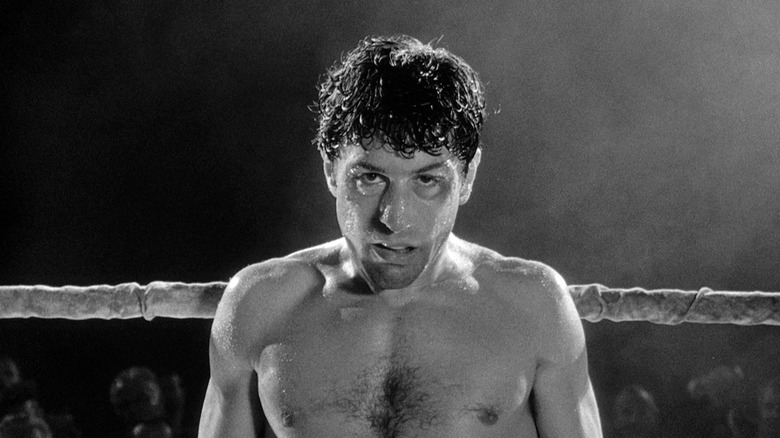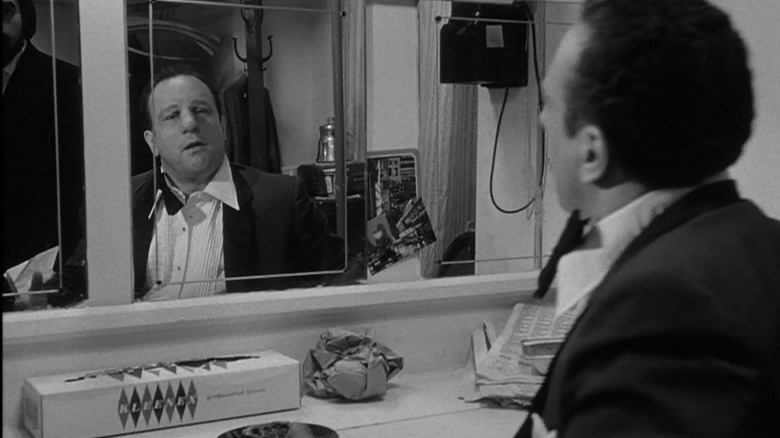The Martin Scorsese Cameo You May Have Missed In Raging Bull
Martin Scorsese is one of the greatest filmmakers of all time. Known for his audacious visuals and memorable needle drops, his films often examine how the harshness of American culture breeds toxic masculinity. He frequently engages with his own Italian-American upbringing in New York City and the Catholic concepts of guilt and redemption. And in the tradition of other iconic directors like Alfred Hitchcock, Scorsese has made cameo appearances in the majority his films.
Sometimes he is more noticeable than others. He can be seen lurking in the background of a shot ("Alice Doesn't Live Here Anymore" and "The Color of Money,"), playing a full-on supporting role in the special case of "Taxi Driver," or supplying a disembodied voice ("The Wolf of Wall Street" and "The Aviator." ). It's also important to note that Scorsese does not appear in his historical films about spirituality such as "The Last Temptation of Christ" and "Silence" — perhaps because their interrogations of faith are too personal, or because he didn't see an organic place to insert himself.
In the case of "Raging Bull," it's a blink-and-you'll-miss-it moment. "Raging Bull" is one of Scorsese's most brutal films. It features a masterful performance from Robert De Niro as Jake LaMotta, a ferocious middleweight boxer whose temper turns him from a prize-winning athlete to an overweight has-been, performing on stage instead of fighting in the ring. Scorsese appears near the end of "Raging Bull" as a stage manager informing Jake LaMotta, who is practicing his "On the Waterfront" monologue, that he has five minutes until showtime. He drifts into the left corner of the frame and is seen as a reflection bifurcated in Jake LaMotta's mirror. In the script, the stage manager is merely referred to as a shadow. Fandor calls him a "spectral, (near-)witness at Jake LaMotta's climactic reckoning," where LaMotta recognizes the Elia Kazan film's parallels to his own life and rebukes his brother Joey for all of his own miserable failures. When the stagehand leaves, LaMotta psyches himself up for the show by shadowboxing — a sign that he will never back down, for better and worse.
But there is deeper meaning behind this brief cameo appearance that ties to Scorsese's singular directorial vision.
Scorsese mirrors himself as a director
Film Inquiry wrote a fascinating analysis of Scorsese's cameos throughout his career, theorizing that by appearing so imperceptibly in small roles, "Scorsese weaves himself into the texture of his films, as if he is one of the screen world's everyday inhabitants," which reinforces his deeply personal connection to his art.
In many of his cameos, Scorsese appears as someone involved with the theatrical process. Much like a film director, a stage manager is the architect of a production; their work and organization makes a performance run smoothly. Scorsese and De Niro's framing in the final scene of "Raging Bull" mirrors their off-screen professional dynamic. The stage manager stands over Jake LaMotta in an authoritative position because his call dictates when the performance will begin. Like LaMotta, De Niro follows Scorsese's lead to go from behind the camera (backstage) to in front of the camera (on stage) in order to play the role of someone else.
Scorsese consistently portrays various elements of the movie director role, such as a spotlight operator in "After Hours" or a photographer in "Hugo." Film Inquiry surmises this is a way for him to "absorb himself into his fictional worlds, whilst subtly reinforcing the idea of him as ever-present creator." Through these characters, Scorsese emphasizes himself as the author of this story, as the person controlling what the audience sees. Scorsese's frequent cameos are exciting to look for, and they leave a quietly profound mark on his distinctive work.

